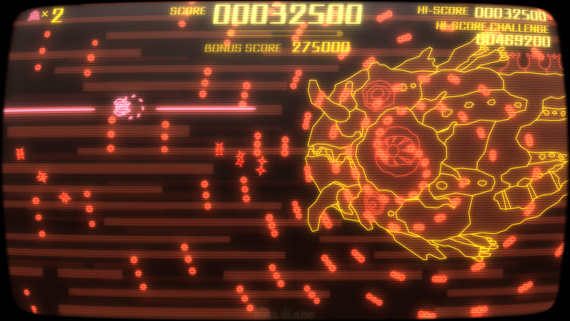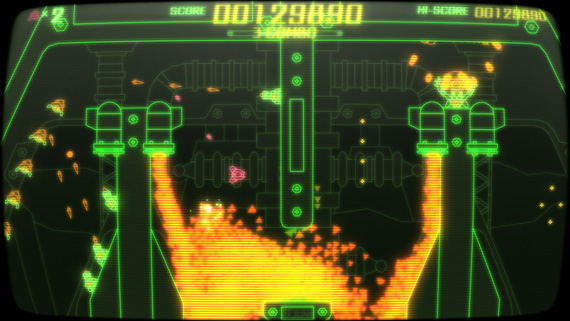
Way back in 1990, when I was but a freshman in high school, I received R-Type for the TurboGrafx-16 as a Christmas present. As anyone who has played the game knows, it is an absolutely punishing horizontal shooter. I lost count of how many times I blasted off to destroy the evil Bydo Empire only to be met with failure, and I’m not too ashamed to admit that I never cleared the final stage. Nevertheless, I refused to give up, and in fact, the game’s extreme difficulty level may have made me love it more.
R-Type requires players to methodically conquer each stage one small step at a time. Getting just a tiny bit further in a level is cause for celebration. The more I played, the further I eventually progressed, learning exactly where on the screen I needed to position my humble spacecraft at any given moment. I can’t think of any other shooter in which so much trial-and-error, memorization, and perseverance is required to succeed.
“But Mister Raroo,” you might wonder, “Why are you spending so much time talking about R-Type in a PixelJunk: SideScroller review?”
Because, dear readers, playing SideScroller is very much like playing Irem’s masterpiece. SideScroller is clearly a love letter to the classic horizontal shooter genre of yore, and it contains elements that bring to mind games like Gradius and Darius, though more than anything, I couldn’t help but think it would fit most comfortably in the R-Type family.

But we should maybe back up a bit here and bring everyone up to speed on just what PixelJunk: SideScroller is. For those of you scratching your heads, SideScroller is a horizontal 2D shooter created in the vein of classic arcade games, particularly from the late 1980s and early 1990s. You take control of a small spaceship (or two spaceships, if you elect to play in co-op mode) and face overwhelming odds as you pass through a series of stages that are filled with enemy ships, turrets, and environmental hazards. SideScroller is actually an offshoot of Q-Games’ PixelJunk Shooter series, and it brings along some of the elements from those titles, which I’ll discuss further in just a moment.
Your modest craft is equipped with three weapons: a machine gun, a laser, and bombs. You can cycle between these weapons to your heart’s content, and picking up power-ups left behind after destroying certain enemies allows you to improve your firepower. Just like Gradius, deciding how to boost your armaments is completely in your hands, through certain weapons work best depending on specific situations. You can also charge up a spin attack that sends you careening into enemies with reckless abandon, but I rarely chose to make use of it. The spin attack usually caused my craft to end up in a more precarious situation than if I would have left well enough alone, so I usually just stuck with the core weaponry and my reflexes.
The machine gun is the weakest of the bunch, but it has the most coverage and fires an incredible amount of bullets. At first I relied heavily upon it, as I imagine most players will be inclined to do, but as I became more proficient at reaching the ends of the stages, I better understood the strengths of the other two weapons. The laser deals out serious damage and can carve through some obstacles like walls of ice, but the time between shots is lengthy, so players will need to be precise in order to be effective. Bombs are actually my favorite way to dish out damage, and I love watching them lumber forth both above and below my ship like depth charges, though they move in a somewhat erratic manner, making them almost impossible to fire with precision and more than a little unreliable in the game’s trickier spots.

Players will need to be patient and accept the fact that they’ll see their little ship explode a lot. Quick reflexes are definitely required, but perhaps even more important is memorizing each stage’s layout and positioning your craft in just the right spot needed for survival, quite like R-Type. Some areas require the navigation of extraordinarily tight pathways, and knowing the placement of obstacles like enemy turrets is instrumental so you can plan your route accordingly. Success, then, stems just as much from being able to learn from one’s mistakes and make necessary adjustments the next time around as it does from having quick reactions and a steady hand. Even on Normal difficulty, the game is anything but a breeze, and some areas were thorny enough that it took a couple dozen tries to clear them.
However, especially when compared to R-Type’s almost insane difficulty, SideScroller is very player-friendly. Developer Q-Games obviously wants players to succeed, and the number of checkpoints peppered throughout the stages is generous. Sometimes there will even be a recurring 1up found right after a checkpoint, which players with a decent amount of knowhow should be able to take advantage of in order to avoid seeing the Game Over screen. However, even if you run out of lives, you can choose to continue from the last checkpoint reached, though your craft will be stripped of all its power-ups.
In that sense, players used to “credit-feeding” shooters and coasting their way through to the end will be in for a shock. SideScroller may be more lenient than many of the classic arcade shooters it references, but the game still expects you to do your part and actually demonstrate some ability.

There is an admirable amount of diversity in the stage design, with each level coming across as unique. Veterans of the PixelJunk Shooter games will enjoy that SideScroller brings with it some of the trademarks those games are known for. For instance, in one level there are a number of volcanoes that can spell doom for your craft if you don’t find a pool of water to dip in after being doused with lava. Another stage has you avoiding spinning blades and walls of spikes. One of my favorite sectors features clouds of gas that will be lit ablaze if you aren’t quick enough to take out the fire-spouting turrets positioned nearby. But even with all these neat environmental hazards present throughout the stages, Q-Games used just the right amount of restraint to ensure the action never gets bogged down and the focus of the game remains on the classic shooter gameplay above all else.
Though the game’s levels are grouped together into sets of stages, each with a daunting end boss, you can actually tackle them out of order. For example, sectors 2-1 and 3-1 were unlocked before I finished the first set of levels (which is a good thing because I was stuck on 1-3 and needed to take a break from it for a little while!). In fact, the levels are actually akin to standalone challenges, especially when considering that weapon upgrades are taken back to square one each time you begin a new sector. I think this is a smart idea, as it forces players to discover the most efficient path through each level, and it ensures consistency and fairness in the online leaderboards.

Speaking of score, SideScroller has a combo meter that you keep active and refill by destroying an enemy before the timer ticks out. Therefore, not only do players need to memorize each level’s layout in order to simply survive, but they’ll need to factor in how to best progress through the stages without letting the combo meter run down. There are also small score bonuses to pick up as well as three hidden PixelJunk icons to find on each level that are usually tucked away in hard-to-reach locations, so some degree of exploration is necessary. SideScroller is the type of game that is ripe for replay, and the most dedicated players will no doubt run though each of the game’s levels countless times to try to improve their scores and find all the secrets.
Some of the most entertaining sections to revisit are the boss battles, which are extremely well executed and pose fair but intimidating threats. The boss overseeing the first set of stages, a massive fish that unleashes streams of missiles and causes debris to fall from above, is an obvious tip of the cap to the Darius series. It took a few tries before I was able to pulverize him, and it turns out he was just the tip of the iceberg. The rest of the pack is much more menacing. My favorite boss is found in sector 3-4 which, without spoiling too much, definitely seems like it belongs in an R-Type game. And for those players that can make it through the game on Normal difficulty, there is yet another challenge waiting…

I absolutely adore the visuals in SideScroller. The game bears more than a passing resemblance to the developer’s wonderful DSiWare release, Trajectile, yet beefed up considerably to take advantage of the Playstation 3’s horsepower.
SideScroller is designed to look as if it is running on a washed-out CRT monitor, and the minimalist vector-like backdrops add to the retro factor. Yet behind this curtain of nostalgia lies some remarkable programming, as there is nary a hint of slowdown even when the stages are overflowing with enemies, projectiles, and special effects like volcanic eruptions made up of too many particles to count. Very impressive!
The amazing art direction comes at a price, though. Each sector is modeled with a dominant color scheme, and enemy fire follows suit. For example, on a level where everything is shaded with a green tint, the bullets fired at your craft are also green, even if their specific hue is unique. This sometimes makes it difficult to discern enemy fire from everything else on screen, especially when you’re using your peripheral vision. On numerous occasions my ship met its end by colliding with a projectile I hadn’t noticed, which my neighbors probably heard me yelling was unfair. The issue lessened significantly as I became comfortable with each stage’s layout and knew just what to expect, but I feel the problem is worth mentioning.

The game sounds just as good as it looks, featuring music that comes across as haunting, alien jazz mixed with bits and pieces of hip-hop. The often mellow soundtrack doesn’t always match the frantic action happening on screen, but somehow that’s what makes it all the more intriguing. I just wish every sector could have had its own music, as some of the tracks are reused a couple of times. Players are aurally rewarded at the game’s final showdown, which features what I consider to be the best track in the entire game.
Oh, and I laughed at the credits screen, with its pumping club-worthy rap jam blazing away while you take control of one of the little spacemen from the PixelJunk Shooter games and blast at the names of everyone involved in the creation and release of SideScroller.
The audience for PixelJunk: SideScroller is likely a limited one, which makes me all the more delighted that Q-Games put so much care into a game that the bulk of Playstation 3 owners will probably pass by without even a second thought. Obviously, the development team has a reverence and respect for classic horizontal shooters, and their attention to detail shows in every conceivable aspect of the game. You’ll need to bring your skills to the table and be willing to put in the time needed to study and master each stage, but if you’re up for the challenge, you’re in for quite the treat. And who knows? Maybe I’ll be able to apply the skills I’ve gained from SideScroller and use them to finally finish R-Type!

Great review! I’ll give this a go next month once I’ve got the time for it.
Comment by EdEN — November 5, 2011 @ 4:44 pm